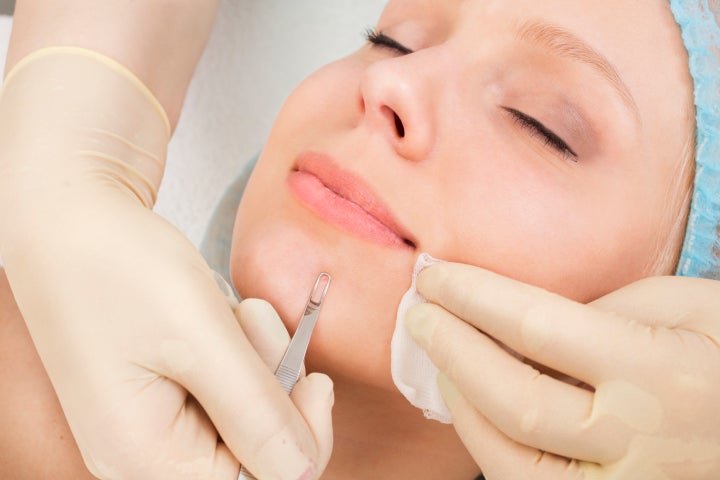
For anyone looking to unclog their pores, there’s nothing more satisfying than a good extraction. Even dermatologists agree they can be beneficial for our skin.
But if not done correctly, you could end up hurting your skin more than helping it. Before you dive head (or nose) first into the world of extractions, there are a few things you should know.
What exactly are extractions? They sound terrifying.
An extraction is exactly what it sounds like: It is a literal extraction of the gunk inside your pores, which could be dirt, makeup, sweat and/or excess sebum. Sebum is an oily substance produced by your body’s sebaceous glands that actually helps protect your skin from certain bacteria and keeps it hydrated. An excess of sebum, however, could lead to acne and those dreaded blackheads.
The process of extractions usually involves an experienced professional (whether it be a dermatologist or a facialist) using special tools or sometimes their hands to apply pressure around a clogged pore to help release what’s inside.
Dr. Michele Farber, a board-certified dermatologist at Schweiger Dermatology Group, said that in her professional opinion, extractions should always be done with an extracting tool, never hands. But Jenna Walsh, skin therapist at Heyday in New York, said the skin therapists where she works use their hands to extract only “what is ready.”
What comes out usually looks like one of two things, Walsh told HuffPost.
“It’s either a hardened ball of oil, which sort of resembles a little sesame seed, coming out of the skin. It feels really hard and almost just rolls off the skin once it’s extracted,” she said. “Alternatively, if the client has a great hydrating routine and is taking care of their skin properly, but still has that buildup from oil and pollution and makeup, what comes out might be really soft, it almost wiggles out and can be wiped away.”
The whole point of extractions, according to Farber, is to get that goop out to help clear up the skin and/or help acne heal more quickly. Extractions can also be done to remove milia, a buildup of protein under the skin that results in small white bumps, Dr. Melda Isaac, a board-certified dermatologist in Washington, D.C., told HuffPost.
Can anything go wrong?
Yes. As Isaac and Farber explained, if extractions aren’t done properly, you could definitely make things worse. For instance, you can be left with scarring or end up pushing the bacteria further into the skin, which may lead to more breakouts.
Isaac told HuffPost, “If you’re pushing in the wrong direction, or pushing too aggressively, you can push the contents ― which you have all the best intentions of getting out ― down into the skin and cause the follicle to become more inflamed, which then triggers more of an acne-like reaction, because you still have that plug in there that fuels more inflammation and bacterial infection.”
Additionally, Farber added that if you’re prodding at the same spot too often, you’ll likely increase your risk of scarring.
“If you’re in the right hands and they’re not pressing too hard and you have nice even pressure, you should be OK,” Farber said.
Active acne lesions or pustules with a living infection inside them should not be extracted, Isaac said, noting that if it’s “red and juicy, [it’s a] no-no.”
As we all know, popping pimples that aren’t ready to be popped is a rule to live by, as you could end up spreading bacteria or giving yourself a scar.
How often should you get extractions?
The amount and frequency of extractions will vary from person to person. Walsh said that many of her clients come in for facials including extractions once a month, while those with oilier skin come in twice a month.
Of course, as Farber noted, you should still always be careful with your skin and assess what’s going on with it before you let someone poke and prod it. And, as noted above, you want to avoid doing extractions on the same spot repeatedly to reduce any risk of scarring. If extractions are keeping your skin clear, she said, they’re totally fine.
“You just have to be in the right hands,” she added.
You probably shouldn’t do them at home.
All three experts we spoke to agreed that you should avoid doing extractions on your own and instead seek help from a professional.
“Everyone will probably try at some point to do their own extractions. I would say not recommended,” Walsh said. “I’ve seen so much scarring resulting from a fingernail or even those extracting tools that they sell at beauty stores.”
As Isaac explained, you don’t necessarily need to go to a dermatologist for extractions, but you want to make sure that wherever you’re going is reputable and clean.
“I wouldn’t be going to the neighborhood place that also does nails and threading all packaged in for a discounted rate,” she said.
According to Isaac, you want to make sure the staff has been properly trained, their equipment and tools are properly sterilized, and that the office has regulations in place to ensure proper training has been completed.
Just remember, extractions won’t solve all your skin woes.
While extractions are good for unclogging pores and potentially clearing the skin, they won’t actually make your pores shrink, and there’s a good chance all the buildup you remove will eventually come back.
“Everyone could use a great detox,” Walsh said, especially those who live in big cities with plenty of pollution in the air. However, it’s not always possible to get everything out.
If you keep on top of your at-home skincare routine though, including exfoliating and hydrating the skin, you can help cut down the buildup and prevent more from forming in your pores, Walsh explained.
“The best way to deal with blackheads is to be ahead of it by using things like alpha hydroxy acids, beta hydroxy acids and retinol,” Isaac said. “Some form of retin-A or retinol will make your skin cells less sticky so you’re going to be less prone to getting these blackheads.”
